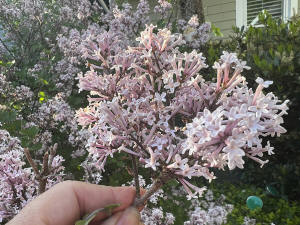Want your garden to smell as good as it looks? These flowers can do the
job
[June 24, 2025]
By JESSICA DAMIANO
For about two weeks every spring, my letter carrier, delivery drivers
and just about everyone else who walks into my yard comments on the
deliciously strong scent emanating from the two lilac shrubs flanking
the front gate. Most days, the breeze carries the fragrance all the way
to the front door or even indoors if the windows are open.
Not many flowers have that power. Some never did. Others no longer do,
thanks to breeding that has developed bigger, prettier, hardier and
disease-resistant plants at the expense of scent. Most carnations and
violas arenít what they used to be, and even some roses are now
fragrance-free.
But if itís an intoxicating perfume youíre after, there are still some
flowers that will make your nose ó and your heart ó happy.
Choosing the ideal fragrant bloom
Of course, not all lilacs are the same. Syringa meyeri Palabin, the
dwarf Korean cultivar I grow, is among the most powerfully fragrant.
Itís suitable for zones 3-7. Other lilac varieties that stand out for
their scent include Syringa x Josee (zones 2- or 3-9), Syringa vulgaris
Krasavitsa Moskvy, also known as Beauty of Moscow (3-7), and Syringa
vulgaris President Lincoln (3-7).
Magnolia, especially the southern grandiflora species (7-9), is another
highly aromatic shrub or tree that puts forth large, sweetly fragranced
flowers youíre not likely to forget. The more cold-hardy sweet bay
magnolia (Magnolia virginiana) will provide a similar service in zones
5-10.
Texas lilac, also known as chaste tree (Vitex), is a beautiful specimen
with purple flowers that bloom in midsummer, imparting a delightful
scent that wafts through gardens in zones 6-9.

[to top of second column]
|

This May 14, 2024, image provided by Jessica Damiano shows a
fragrant Palabin lilac in bloom on Long Island, N.Y. (Jessica
Damiano via AP)
 Old garden roses, the original
heirloom varieties that havenít been tinkered with, are less popular
today than modern hybrids and cultivars, in part because they bloom
just once a year. But their powerful, true-rose fragrance is worth
the tradeoff. Consider roses in the tea, gallica, damask and alba
classes for the most intense scent.
As far as vines go, the scent of star jasmine (Trachelospermum
jasminoides), a climbing evergreen vine with star-shaped white
flowers, will stop you in your tracks. Itís perennial in zones 7-10;
elsewhere, grow it with support in a large pot placed where you
spend most of your time, then move it indoors over winter. Although
not related, common jasmine (Jasminum officinale) also smells as
good as it looks.
Dutch ó or common ó hyacinths (Hyacinthus orientalis) make the early
spring garden smell delightful. Think ahead and plant a grouping of
bulbs by the front door in autumn in zones 4-8.
Sweet peas (Lathyrus odoratus), not to be confused with edible
garden peas, are annual plants beloved for their intense, sweet
aroma. Other beautifully scented annuals include heliotrope
(technically a tender perennial in zones 9-11) and flowering tobacco
(Nicotiana), although, these days, some varieties are more fragrant
than others. When shopping, let your nose be your guide.
___
Jessica Damiano writes weekly gardening columns for the AP and
publishes the award-winning Weekly Dirt Newsletter.
All contents © copyright 2025 Associated Press. All rights reserved |